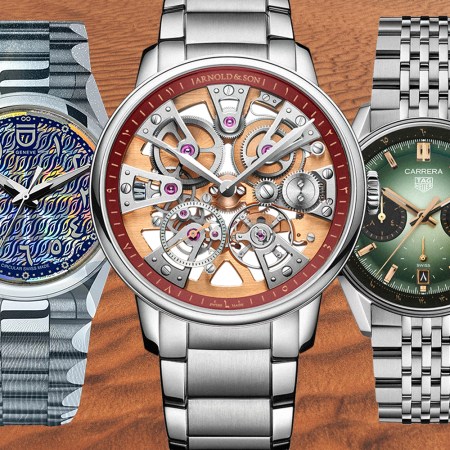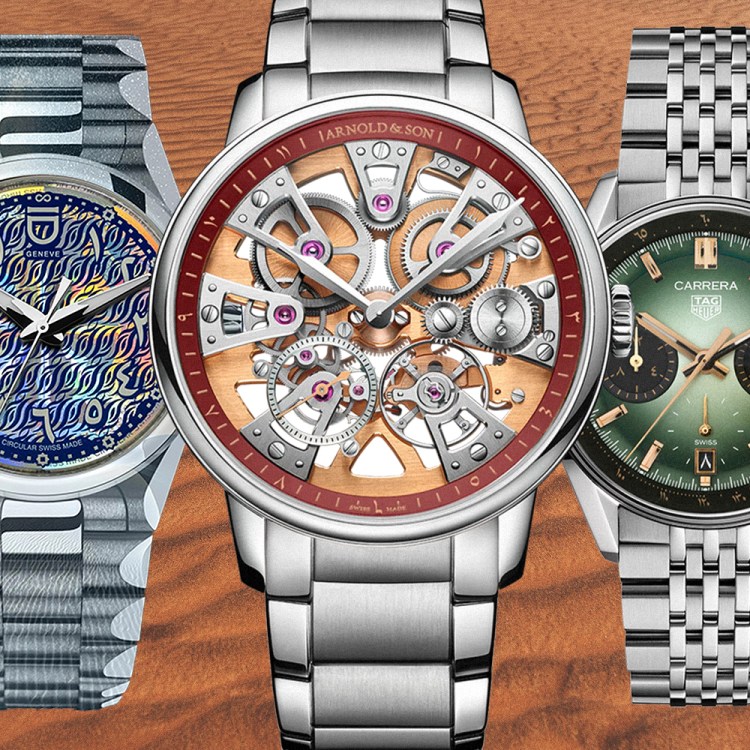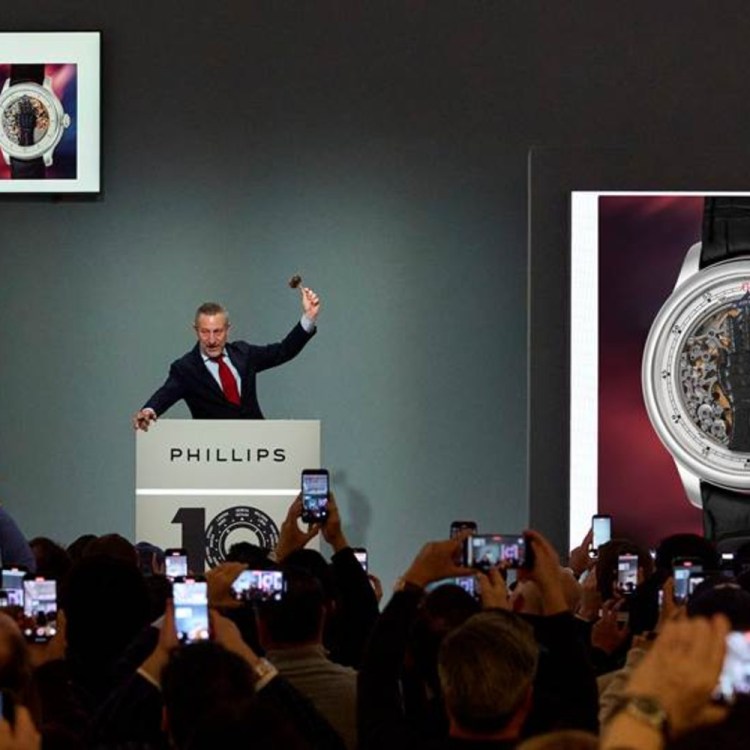Have you been getting an earful from your watch collector friends about “complications” and have positively no idea what they’re talking about? Well, you’ve come to the right place. It actually isn’t all that complicated, after all.
A “complication” is any feature of a watch other than basic time-telling. That little window that displays the date is technically a complication. A chronograph, which measures elapsed time, is also a complication. There are many such complications, some of which are so exceedingly sophisticated they increase the sticker price of a watch into the hundreds of thousands — or millions — of dollars. (One thing to note: When we speak of complications, we’re generally referring to the mechanical kind.)
In an effort to catalog this array of fascinating and complex mechanical wonders, we’re going to define each and show you an example timepiece we feel illustrates the watch complication well. Then we’re going to get the hell out of the way and recuse ourselves while you visit your local Boucheron or Wempe.

The Date Window
Yes, the date window is technically a watch complication. The most famous implementation of this humble (yet supremely useful) feature is perhaps the Rolex Datejust. Launched in 1945, it was named for the precision with which the date flips over exactly at midnight. Still produced 70 years later, the Datejust is said to be the Crown’s best-selling model. (An interesting tidbit: According to market data, watches with date functions far outsell those without them.)
Grab the Year’s Coolest Chronograph Before It Sells Out
This fresh white-dialed take on the Porsche Design Chronograph 1 is limited to just 136 pieces
The Chronograph
Designed by Louis Moinet in 1816, “chronograph” comes from the Greek words khrónos (“time) and gráphō (“to write”) — i.e. a time-recording device. Integrated into an otherwise simple wristwatch such as Omega’s brilliant Speedmaster, it allows the user to time events, such as laps. When integrated with different dial scales, it can be used to measure time, distance, production rates and more.

The Flyback Chronograph
This even more complicated take on the simple chronograph is particularly useful for timing intervals: Rather than needing to stop the chronograph before resetting it, the user simply pushes a single button that returns the hands to zero and sets them running again. This way, successive events (such as laps) can easily be timed with accuracy. The Longines Spirit Flyback Chronograph is an excellent modern example.

The Split-Seconds Chronograph
A step up in sophistication from the flyback chronograph is the split-seconds chronograph, which features dual chronograph seconds hands. Both are started together, after which one can be stopped while the second continues. This brilliant system allows for the timing and recording of successive events such as laps. Try it with Richard Mille’s mind-bending RM 65-01 watch.

The Day-Date
Once again, Rolex was present at the beginning of the revolution in a particular complication, this time with the day-date display. In 1956, for the first time, it displayed both the date and the day in an arc at 12 o’clock. Many other watches (such as those powered by the famed Valjoux 7750 movement) display them sequentially one after the other; IWC replaced this movement more recently with its own in-house calibers boasting the same functionality.

The Full/Complete Calendar
Once a fixture in midcentury watch production, the full or “complete” calendar has since given way to the more sophisticated annual or perpetual calendar. In short, the full calendar displays the day, date, month and sometimes the phase of the moon but must be manually adjusted at the end of each month to account for differences in month length. A notable modern version is the Vacheron Constantin Fiftysix Complete Calendar, available in multiple configurations.

The Annual Calendar
This sophisticated mechanism, invented by Patek Philippe in 1996, is actually a simplification of the perpetual calendar. That doesn’t detract from its impressive quality, however: The annual calendar not only displays the day, date, month and phase of the moon but also automatically adjusts for months of different lengths throughout the year. Patek, in particular, will sometimes combine this functionality with other complications such as chronographs.

The Perpetual Calendar
The perpetual calendar or “QP” (for quantième perpétuel) is a calendar that accounts for the difference in not only month lengths but also year lengths, meaning it can tell whether or not it’s a leap year and thus adjust for February’s length. (Typically such a calendar will have to be adjusted manually after a century or so but sometimes not for much longer.) Given the sophisticated mechanisms governing their operation, QPs are often quite expensive.

The Minute Repeater
The minute repeater is a subset of “chiming” watches, or those that audibly indicate the time (or subdivision of time) using a set of small hammers that mechanically beat against a metal gong within the movement. By activating a slide or button, the hammers sound the hours, quarter-hours and minutes in the manner of a grandfather clock, allowing one to know the time without glancing at their watch dial.

The Tourbillon
Patented by famed French watchmaker Abraham-Louis Breguet in the early 19th century, the tourbillon (French for “whirlwind’) places the watch’s escapement within a rotating cage that offsets the effects of gravity, thus increasing a movement’s accuracy. This expensive tech was cutting edge in the pocket watch world; in the wristwatch world, it’s employed by watchmakers more as a show of savoir-faire, or “know how.”

The World Timer
Invented in modern form by Emmanuel Cottier and developed into a successful prototype by his son Louis Cottier, the world timer (or “world time”) complication displays all (or most of) the world’s time zones simultaneously. Often this is achieved with the use of a rotating inner 24-hour ring in combination with a city ring and a conventional handset. Patek Philippe still employs this system — which it helped popularize in the 1930s — in its world time watches.

The GMT
The GMT watch was — yet again! — a Rolex invention. In 1955, the Crown debuted a design made for Pan American Airways pilots that allowed for the simultaneous display of both a local time zone and an additional time zone. Achieved via the use of a fourth hand and a rotating 24-hour bezel, it’s still best encapsulated by the Rolex GMT-Master II, although myriad other marques also make GMT models.

The Jump Hour
Rather than display the time with a slowly sweeping hour hand, the jump hour watch uses a window and a rotating disc that instantaneously “jumps” to the following hour at the appointed time. (Some, such as A. Lange & Söhne’s exquisite Zeitwerk series, use this same system to display the minutes.) Developed in the 19th century, jump hour watches came to prominence during the 1920s.

The Moon Phase
Often paired with calendar displays, the moon phase displays the, well, phase of the moon. It does so via a small cutaway in the dial behind which a disc rotates depicting the moon in its various monthly guises. Often considered a more whimsical or “poetic” complication, the moon phase display is a distinctly romantic addition to a dressier watch such as the Jaeger-LeCoultre Master Ultra Thin.

The Alarm
Pioneered by Vulcain with its Cricket watch — which was traditionally gifted to sitting U.S. presidents — the alarm watch includes a mechanism similar to that of the repeating watch in which a small hammer beats against a vibrating membrane. Using a fourth hand to set the alarm time, the user can then program an audible reminder to sound at the appropriate hour. Vulcain still makes its famous Cricket, and J.L.C. still makes its Memovox.

The Power Reserve Indicator
Any movement features a power reserve, the amount of time it can run after being wound. Certain watches will indicate remaining tension in the mainspring via a special indicator on the dial, which can be particularly handy on a hand-wound watch. The NOMOS Tangente Date Power Reserve does this in a particularly attractive, Bauhaus-inspired manner, with a red disc that pops against the dial’s otherwise stark white surface.
This article appeared in an InsideHook newsletter. Sign up for free to get more on travel, wellness, style, drinking, and culture.



























